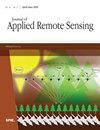Convolutional neural network-based crowd detection for COVID-19 social distancing protocol from unmanned aerial vehicles onboard camera
IF 1.4
4区 地球科学
Q4 ENVIRONMENTAL SCIENCES
引用次数: 0
Abstract
Social distancing is a feasible solution to break the chain of the spread of coronavirus disease 2019 (COVID-19). A human crowd detection model was trained with a computational load that can be handled by a companion computer on the unmanned aerial vehicle (UAV) to minimize the spread of COVID-19. The model is designed to be able to measure social distance between people, whether it exceeds predetermined safe limits (1.5 m). The convolutional neural network model was trained using a dataset of 9600 images featuring humans, cyclists, and motorcyclists, with an allocation of 200 images each for testing and hyperparameter tuning. The image dataset was extracted from videos recorded above the UAV in the Institut Teknologi Bandung area, capturing diverse crowd scenarios throughout the day. The pre-trained model for transfer learning method is a single shot detector with MobileNet, ResNet50, and ResNet101 architectures. The measurement of the estimated social distance uses the Euclidian distance with the average Indonesian human as a reference, which is 1.6 m. MobileNet V2 was chosen as a crowd detection model with a lightweight size, which is only 19 MB and the average detection runtime for a single image is only 0.606s, in accordance with the load for the onboard companion computer. MobileNet V2 is also able to detect crowds of people well with the precision value reaching 84.9% and the recall value reaching 87.8%.基于卷积神经网络的新型冠状病毒社交距离人群检测:无人机机载摄像头
保持社会距离是打破2019冠状病毒病(COVID-19)传播链的可行方案。训练人群检测模型,计算负载可由无人机(UAV)上的同伴计算机处理,以最大限度地减少COVID-19的传播。该模型旨在能够测量人与人之间的社会距离,是否超过预定的安全界限(1.5米)。卷积神经网络模型使用9600张图像的数据集进行训练,这些图像包括人类、骑自行车的人和摩托车手,每个图像分配200张用于测试和超参数调整。图像数据集是从万隆理工学院地区无人机上方录制的视频中提取的,全天捕捉不同的人群场景。迁移学习方法的预训练模型是具有MobileNet, ResNet50和ResNet101架构的单镜头检测器。估计社会距离的测量以印度尼西亚人的平均欧几里得距离为参考,为1.6米。选择MobileNet V2作为一个轻量级的人群检测模型,其大小仅为19 MB,单张图像的平均检测运行时间仅为0.606s,符合车载配套机的负载。MobileNet V2也能很好地检测人群,准确率达到84.9%,召回率达到87.8%。
本文章由计算机程序翻译,如有差异,请以英文原文为准。
求助全文
约1分钟内获得全文
求助全文
来源期刊

Journal of Applied Remote Sensing
环境科学-成像科学与照相技术
CiteScore
3.40
自引率
11.80%
发文量
194
审稿时长
3 months
期刊介绍:
The Journal of Applied Remote Sensing is a peer-reviewed journal that optimizes the communication of concepts, information, and progress among the remote sensing community.
 求助内容:
求助内容: 应助结果提醒方式:
应助结果提醒方式:


